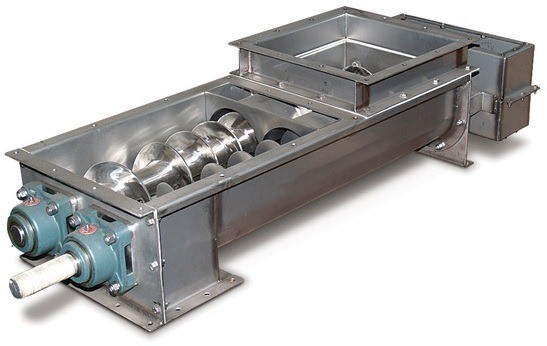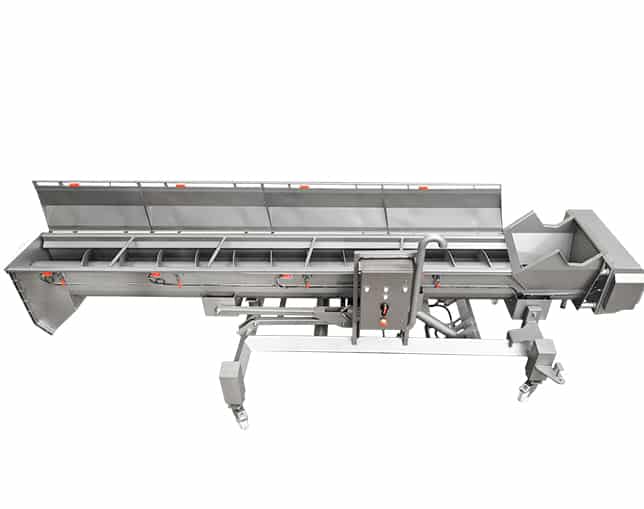
Screw Conveyor Working Principle
Screw conveyor relies on the rotation of the screw blades in the cylindrical conveying tube to push the material forward. When the motor drives the spiral shaft rotation, the spiral blade and the material between the friction and thrust, so that the material is transported along the conveying pipe. The material is stirred and pushed by the screw blades in the conveying process, thus achieving continuous and stable conveying. The core of its working principle lies in the rotary movement of the screw blades and the interaction with the material.

Screw Conveyor Types
Horizontal screw conveyor is one of the common types, which is mainly used for short and medium distance material conveying in the horizontal direction, and is widely used in the material conveying link of factory workshop. Inclined screw conveyor has a certain angle of inclination, can adapt to the different height difference of the material conveying needs, commonly used in the material from the low place to the high place. Vertical screw conveyor has a unique design, which is specially used for lifting materials in vertical direction, and it can play an important role in occasions with limited space, effectively saving floor space.
Advantages of Screw Conveyors
Firstly, the structure is relatively simple and compact, which means it is easier to install and dismantle, and also reduces manufacturing and maintenance costs. Secondly, it has a strong conveying capacity and can handle a large amount of material, and the conveying process is smooth and continuous, which ensures high production efficiency. In addition, good sealing effectively avoids material leakage and dust phenomenon, which helps to keep the working environment clean and safe. In addition, its arrangement is flexible and diversified, and can be reasonably laid out and adjusted according to the specific site conditions and process flow.
How to choose screw conveyor
When choosing a screw conveyor, the characteristics of the material to be conveyed need to be fully considered. The particle size of the material, humidity, viscosity and other factors directly affect the form of the screw blade and material selection. Conveying distance and height are key considerations, which determine the type, length and drive power of the conveyor. Conveying capacity requirements are also crucial to ensure that the conveying capacity of the selected conveyor matches the actual production requirements. At the same time, the characteristics of the working environment, such as temperature, humidity and corrosiveness, will also affect the protective measures of the conveyor and the choice of materials for corrosion resistance.
Screw conveyor maintenance
Regular comprehensive inspection is an important part of the maintenance work, including a careful look at the wear condition of the screw blades, the lubrication status of the bearings and the degree of fastening of the various connecting parts. Timely and thorough cleaning and maintenance is essential to prevent residual material build-up inside the conveyor, avoiding clogging and affecting normal operation. The lubrication and maintenance of the key parts should follow the prescribed cycle and standards to ensure the good operation of the bearings and transmission parts and extend the service life of the equipment. Once the parts are found to be seriously worn or faulty, they should be quickly replaced and repaired to ensure that the screw conveyor is always in the best working condition.
Screw conveyor application
In the building materials industry, screw conveyor plays an important role in conveying materials such as cement, sand, gravel, bricks and so on, which provides strong support for the efficient operation of the production line. In the chemical industry, all kinds of chemical raw materials and finished products can not be transported without the precise operation of screw conveyor. In the grain industry, it plays an indispensable role in both the storage and transport of grain. In the environmental protection industry, for the treatment and conveying of rubbish, slag and other solid wastes, screw conveyor also shows excellent performance and adaptability.
In summary, the screw conveyor with its unique working principle, a variety of types, significant advantages, scientific selection methods, careful maintenance measures and a wide range of applications, in modern industrial production occupies an important position for the development of various industries to provide a solid guarantee of material transport.

Screw conveyor needs to pay attention to the following problems in the process of using:
Common failures of screw conveyor include:

Screw conveyor has many significant benefits in practical application.
It can achieve efficient and stable continuous material conveying, which greatly improves the production efficiency and meets the needs of large-scale production operations. Its structure is compact and occupies less space, which makes it easy to install and arrange in places with limited space, and will not bring too much pressure to the site. In the conveying process, due to the ability to achieve airtight conveying, effectively preventing the leakage of materials and dust phenomenon, not only to ensure a clean and hygienic working environment, but also minimise the loss of materials and reduce the pollution of the environment.
Screw conveyor has a high degree of flexibility in conveying distance, according to the specific production requirements and site conditions, to achieve the length of the material conveyor. For a variety of different forms, particle size and nature of the material, such as powder, granular, small pieces, etc., it has good adaptability, showing a strong versatility.
Operation, the screw conveyor is relatively simple and convenient, reliable operation, routine maintenance costs are not high, for enterprises to save manpower and material resources. And its arrangement is rich and diverse, whether horizontal, inclined or vertical, can be flexibly arranged to fully meet the requirements of complex and diverse processes.
In addition, it is also able to achieve more accurate quantitative conveying, which is of great significance in realising the automatic control of the production process, and helps to improve the precision and stability of production. The noise generated during operation is relatively low, helping to create a relatively quiet working environment. In the long run, the screw conveyor has a high cost-effectiveness, in the use of the process can create significant economic benefits for the enterprise, is an indispensable important equipment for many industries.